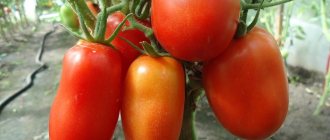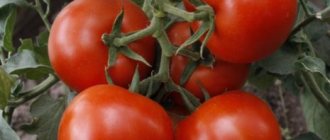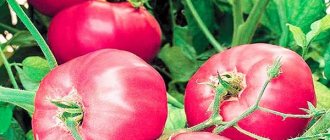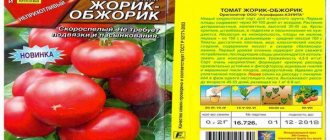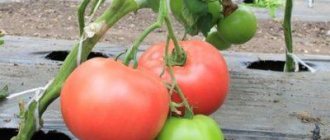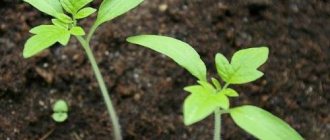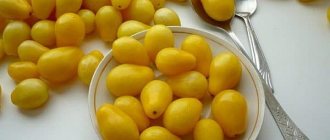The Charm tomato is especially loved by summer residents who prepare a lot of cans of preserves for the winter. The fruits of the variety are ideal for these purposes, as well as for fresh consumption, processing and culinary use.
| Height | Landing location | Ripening time | Fruit color | Fruit size | Origin | Fruit shape |
| Tall | Greenhouse, Open ground | Mid-season | Orange | Average | Variety | Round |
Taste qualities of fruits
Charming tomatoes are classified as mid-season varieties, which means that the first harvest appears 110 - 120 days after sowing the seeds. The fruits are not large, weighing 100 - 130g, have a round shape and a dense, smooth orange skin. The pulp of tomatoes is juicy and sweet with a small number of small seeds. Description of tomatoes Charm is fully confirmed by photos of gardeners who have already grown this variety.
The fruits contain up to 3 mg of beta-carotene, which is significantly more than in red-fruited varieties. To preserve all the vitamins, it is recommended to consume tomatoes fresh. However, they are also suitable for whole-fruit canning. And in combination with other varieties of tomatoes, the marinade acquires a special taste. Charm tomatoes are also used for making juices. But for these purposes it is better to choose very ripe fruits. Then the juice will turn out to be a rich orange color with a pronounced aroma and sweet taste.
Resistance to diseases and pests
One of the significant advantages of this variety is resistance to most tomato diseases, but we should not forget about prevention against fungal diseases. To do this, use special products that contain copper; they can be purchased at a gardening store.
Don’t forget about protection from pests, so take preventive measures against:
- whiteflies;
- slugs;
- caterpillars;
- spider mites;
- aphids.
The best way is to use special products that can be purchased at a gardening store.
Pros and cons of the tomato variety Charm
According to the description and characteristics of Charming tomatoes, we can highlight some advantages over other varieties:
- high productivity;
- variety resistance to drought and early autumn frosts;
- immunity to common diseases: cladosporiosis, tobacco mosaic virus, alternaria and bacteriosis;
- fruits with a strong and smooth skin have a sweet, aromatic pulp.
As for the minuses, gardeners do not note any significant negative traits in this variety of tomatoes.
Care instructions
To be able to count on a good harvest with tasty fruits, during the process of growing the variety you should:
- carry out regular removal of all branches and leaves that appear under the first cluster of fruits formed (on each bush);
- when carefully tying, pay most attention to the hands and reduce the load on the stem itself in order to prevent their fractures;
- water the bushes in such a way that the soil around the stems does not collapse under the influence of the stream;
- fertilize the soil using mineral complexes;
- regularly weed the area to remove weeds and loosen the soil itself to increase its breathability;
- carry out preventive treatments of plants using copper sulfate and sulfur.
Plants respond quite well to applied fertilizers, but they should not be applied more than 3-4 times during the entire season, since an excessive concentration of chemicals can cause burns to the root systems and damage to the bush itself.
Agricultural technology tomato Charm
To grow strong and viable tomato seedlings, you need to adhere to the rules of agricultural technology. The correct choice of soil, timely picking of plants, moderate watering and fertilizing are important components for obtaining a good harvest.
Growing seedlings
The process of growing tomato seedlings The charm begins with choosing the right material for planting. This could be soil purchased at a specialty store, or soil from the garden.
Important! When using soil from the garden, it must be calcined in an oven. This will protect the seedlings from fungal diseases.
Planting tomatoes can be divided into several stages:
- You need to buy seeds and be sure to pay attention to the expiration date. If they are older than two years, then there is a high probability that seedlings will not appear.
- Place the seeds in a small glass and fill them with water at room temperature. After an hour, see which seeds have flared up and remove them: they are definitely not suitable for planting.
- Pour the soil into previously prepared containers. Water the soil well, make holes 1.5 cm deep and place seeds in them.
- After planting, cover the container with cling film and place in a warm, sunny place until the first shoots. When the first leaves appear, remove the film.
- As soon as 4 - 5 leaves appear on the sprouts, you need to make a pick - plant the seedlings in separate pots or a common container according to the 10x10 pattern.
Planting in a permanent place (in open ground or a greenhouse) is best done in the middle or end of May to avoid the return of frost.
Landing rules
To transplant tomatoes into open ground or a greenhouse, you need to prepare the soil in advance. In the fall, you should dig up the soil to a depth of 30 cm and add organic fertilizers. And in the spring, after the snow melts, use mineral fertilizer.
A few days before planting the plants, it is recommended to dig up the soil again to a depth of 20 - 25 cm. It is better to replant tomatoes in a permanent place on a cloudy day or in the evening, so that the sun's rays do not burn the leaves of the seedlings.
Before planting, you should thoroughly moisten the soil in the pots in which the sprouts are located. This will help you remove the plants easily and not damage the root system. In open ground, the depth of the holes should be 10 - 15 cm, and in a greenhouse no more than 20 - 25 cm. The recommended planting pattern is 80x60. After planting all the seedlings, you need to water the soil and cover the plants with film at night for 3 - 4 days to protect the young bushes from frost.
Important! To plant tomatoes in open ground, it is better to choose a place where carrots, onions or cucumbers previously grew.
Watering and fertilizing
After transplanting, you need to wait 5 - 7 days for the plants to get used to the new place. Then water the tomatoes and then water them 1-2 times a week, following some rules:
- Do not allow water to get on the leaves.
- It is not recommended to water plants with a hose. It is better to fill several containers with water in advance so that it heats up and settles.
- Watering should be done early in the morning, before the onset of extreme heat, or in the evening.
During the growth period for Charming tomatoes, three feedings are done. The first is carried out 10 - 14 days after planting in a permanent place. To do this, you need to mix 1 kg of manure per 10 liters of water. You can also use other fertilizers: mix 15 g of ammonium nitrate, 60 g of superphosphate and 40 g of potassium sulfate per 10 liters of water.
It is better to carry out the second feeding a week after the second cluster opens and the ovary is 1.5 cm thick. It is necessary to mix 1 kg of manure with 10 liters of water, 1 tbsp. l. any mineral fertilizer, 3 g of manganese and copper sulfate. Each bush will require 2 liters of solution.
The third feeding is necessary during the ripening of the first fruits. You can use the same solution as during the second feeding. However, there is a possibility that the leaves will begin to grow rapidly, and the formation of flowers will stop altogether. In this case, you need to stop giving organic fertilizers and start feeding with superphosphate extract.
Pinching and tying
Pinching is the removal of excess shoots, which take the bulk of nutrients, preventing the plant from forming fruits. Only those shoots that appear between the main stem and the leaf should be removed. The first stepsoning is carried out 10 - 14 days after planting: at this time the stepsons can be less than 1 cm. In the future, the stepsons need to be harvested regularly (every 6 - 7 days) and even after the harvest appears.
Tomato tying is carried out 10 - 14 days after planting in a permanent place. At a distance of 10 cm from the main stem, you need to stick a peg into the ground. Its length should be at least 10 cm higher than the length of the bush. They are tied under the brush on which the fruits are formed. During the entire growth period, 3-4 garters are made. This is a mandatory procedure that will help the fruits not come into contact with the soil and protect the plants from diseases.
Formation
The tomato variety Charming is indeterminate, which means it can grow upward indefinitely. Therefore, the bush is formed into one stem. To do this, after planting in the ground, all stepsons and side branches are removed. These actions need to be repeated regularly. With the appearance of the first fruits, the growth of the stem in length should be stopped by removing the top of the plant. This is necessary for the full ripening of the fruits that have already appeared.
Protection from diseases and pests
To protect Charm tomatoes from diseases, it is recommended to periodically spray the bushes with products that contain copper. This will help avoid the occurrence of fungal diseases. Special insecticides should also be used to prevent insect pests, such as Thunder, Phosbecid and others. It is better to process tomatoes in the early morning or evening so that the solution on the leaves does not come under the scorching rays of the sun.
In addition, to prevent diseases of Charming tomatoes, you need to carefully monitor the humidity and regularly loosen the soil. This will protect tomatoes from gray rot and late blight.
General characteristics of the plant
The bush is indeterminate; the growth of the main stem continues throughout the summer. In the greenhouse, Charm tomatoes grow up to 1.9-2 m, and form fruit clusters throughout the season. The yield of the harvest is extended, but the fruits on each cluster ripen almost simultaneously.
The productivity of the variety is high. With the formation of 1 stem recommended for a greenhouse, it is possible to harvest 3.5-4.5 kg of tomatoes from each bush. With dense planting (4-5 bushes per 1 m²), the owner’s efforts will be rewarded with a bountiful harvest.
Fruit characteristics:
- The fruits are collected in simple long clusters arranged in a cascade on the plant.
- The weight of an average tomato is 100 g; fruits of approximately the same size, round and smooth, are collected in brushes.
- When ripe, the tomato gives an unusual shade of decorative charm; the fruits have a bright, almost orange color. The high carotene content gives this color to the skin and pulp of the fruit. Thanks to this, orange tomatoes have a higher nutritional value.
The plant is powerful, has a high tendency to branch and needs pinching and staking. Charming tomatoes are resistant to tobacco mosaic, immune to bacteriosis and resistant to fungal diseases. Resistance to late blight is average; to prevent the disease, after tying the tassels on the plant, the lower leaves are removed.
The Charm variety can be grown both in open ground and in greenhouses. Reviews from vegetable growers indicate the resistance of tomatoes to unfavorable environmental conditions. The yield of the variety is relatively stable in any summer season and does not depend on the growing method.
See also
Characteristics and properties of Cypress tomato, pest control
Read
How to choose high-yielding and low-growing tomato seeds?
Low-growing tomatoes are scientifically called determinate. Having reached a certain height (usually up to 1 m), they stop growing. The fruits on them ripen quickly and uniformly, but they are less productive than indeterminate ones, or not limited in growth. But there are such low-growing tomatoes that can easily compete in yield with their endlessly growing brothers. To make it easier for you to choose seeds for this season, we hasten to tell you which tomato seeds are productive and stunted at the same time.
Productive low-growing tomatoes for open ground and film cover
The bushes stop growing after they reach a maximum of 60 cm in height. Alaska tomatoes are primarily intended for growing in open ground, even in regions with short summers. But when planting in a film shelter, you can also confidently hope to get a good result. Resistant to diseases. Tomatoes weighing up to 100 g ripen very early and amicably, and are distinguished by their neat shape.
Excellent half-meter tomatoes for growing in open and closed ground. The riddle belongs to the ultra-early varieties, is resistant to many diseases and tolerates a lack of sunlight well. Small red tomatoes (up to 100 g) never crack and are suitable for any purpose.
By planting the seeds of this low-growing tomato in a plot with or without shelter, you can safely expect an early good harvest of sweet and juicy tomatoes, oblong in shape, which are suitable for both salads and canned food. Their weight can reach 300 g, they form fancy clusters that look very interesting. If the bush is not limited in growth, it can stretch more than a meter.
Very unusual tomatoes that look like apples. They contain a high percentage of dry matter and sugar and do not crack. They can reach a weight of 300 g, which makes them suitable only for fresh consumption and preparation of tomato mass. Hazel grouse has an average ripening speed, the height of the bush is 60-75 cm.
If you want to collect large, sweet and very aromatic fruits from low tomato bushes, then choose Pink Honey tomato seeds. Meter-long bushes of this variety produce a good harvest of delicious fruits, the average weight of which is 200 g, but there are specimens up to 1 kg. This variety of tomatoes is considered salad and mid-season.
This is a relatively new productive variety of tomatoes for open ground, intended mainly for canning and pickling. They are distinguished by a particularly high dry matter content and excellent quality and taste. Ripening is early, the average weight of the fruit is 100 g. The Watercolor variety is unpretentious, half-meter bushes do not require additional efforts for pinching, staking and fighting septoria and blossom end rot.
Plum-shaped yellow tomatoes, weighing up to 80 g, are perfect for various purposes, including whole-fruit canning. Tomato bushes of this productive variety do not exceed 70 cm in height, develop well without pinching and tying under cover or without it, and show good disease resistance. The fruits are considered very tasty and store well.
Which tomato seeds are productive and low-growing at the same time? Now you know the answer to this question and can make the right choice. But do not forget that to obtain the amount of harvest indicated on the seed package, correct agricultural technology is very important.
Watch a video about shaping low-growing tomatoes
Reviews
Vadim Sergeevich, 37 years old
To prevent diseases of charm tomatoes, you can also use home recipes. For example, at the first appearance of brown spots or plaque, you should remove everything spoiled from the area and bushes, and then thoroughly spray with a solution of low-fat kefir (1 liter per 10 liters of water). The procedure can be repeated after a ten-day break. You can replace the kefir solution with a 1% solution of Bordeaux mixture.
Valentina Mikhailovna, 53 years old
In the prevention of diseases, you can use sifted and dry wood ash. It is first boiled in a volume of 500 g in 1.5 liters of water, and then the resulting mixture is added to 10 liters of clean water. Before using the solution, it is recommended to rub about 50 g of laundry soap into it.
The Charming tomato was bred by Russian agro together with the Pridnestrovian Research Institute of Agriculture. In 1999, the variety was entered into the state register and its sale was allowed throughout Russia.
Important advantages of the variety
The variety of delicious bright orange tomatoes Ocharovanie enjoys special respect among active, experienced gardeners thanks to:
- tolerance to prolonged drought associated with high air temperatures and lack of regular watering;
- resistance to sudden cold snaps while maintaining the ability to form the ovaries of future fruits;
- the presence of natural immunity against tobacco mosaic viruses, Alternaria, TMV and cladosporiosis.
Thanks to its characteristics, the variety is characterized as unpretentious and at the same time very productive.
